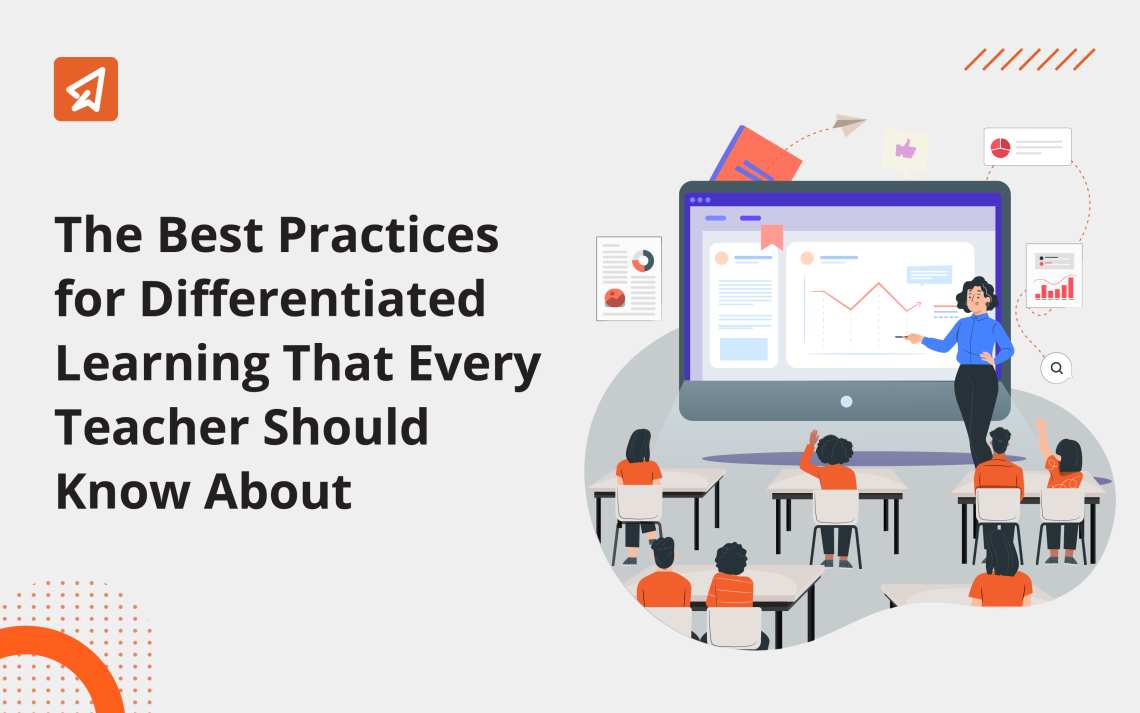Best Practices for Differentiated Learning That Every Teacher Should Know About

We all have distinctive ways of accomplishing goals – be it learning a new language, playing an instrument, a sport or any other activity. Similarly, in a classroom environment, each student is different and is able to learn effectively only when their required academic needs are met. As an educator, it is important to understand how you can best cater to students with varied learning styles and ensure that they are able to keep up with the academic pace. This is mainly why there is such a strong focus on tailoring lesson plans based on students’ individual strengths, needs, preferences and interests – also commonly known as differential instruction.
In this blog, you will learn about the best practices for differential instruction, how they can be implemented effectively and some additional resources that teachers can benefit from. Let’s dive right in.
What is Differentiated Instruction and Why is it Crucial?
The term differentiated instruction means bringing about a difference to the manner in which instructions are delivered in a classroom. To break it down further, differentiated instruction is a teaching approach that revolves around understanding students’ individual learning styles and needs before developing a lesson plan. When students are presented with multiple ways to acquire information, it helps them feel more confident and motivated to learn and perform better.
So rather than teaching an entire classroom using a single approach (such as a verbal lecture), teachers incorporate a bunch of different methods to engage students and help them achieve their learning goals.
You’re probably wondering if it’s actually necessary to practice this approach and use differential instruction in every class? Well, there aren’t really any ground rules and so teachers are free to choose any approach that they think works best for their students. Incorporating differential instruction simply makes classes more engaging, maximizes learning outcomes and allows teachers to zero in more closely on individual student needs.
The process may involve curating different forms of content like videos, case studies, notes, presentations, etc. to keep up with diverse learning needs. The Extramarks platform, for instance, offers a vast repository of content in multiple formats that involves a winning combination of active and interactive learning. From game-based modules, pop-quizzes, active prompts, animated content, recorded lectures, video solutions and case studies – the platform is a one-stop solution for complete learning.
When students are given the individual attention and academic support that they need, it can make a world of a difference to both the teaching and learning experience.
Differentiated Instruction Strategies That Teachers Should Know About
If all students in the classroom were taught in the same way, some may struggle to keep up, whereas others would learn more quickly than their peers. This is why a more refined and inclusive approach to teaching is necessary to ensure that all students achieve their learning objectives.
It was renowned American educator, Carol Tomlinson who introduced the concept of differentiation in the 1900s and identified four main strategies to differentiate instruction effectively. Let’s get an in-depth understanding of each strategy and why they are important.
– Content
Teachers may not be the sole decision-makers of designing the academic curriculum but can curate how they’d like to present the content to meet its objectives. They can differentiate content by offering flexible delivery options and tailor assignments to maximize efficiency.
Here are some examples of differentiating content:
1. Using leveled reading materials
2. Using videos, presentations, audio, etc.
3. Using tiered content
– Process
This refers to the practices and exercises that students perform in order to understand the content thoroughly. Effective differentiation in the classroom will cater to varied learning styles like verbal, visual, auditory and kinesthetic with tailored content for each. Teachers may encourage students to pair up, work with small groups or even facilitate one-on-one classes for students who may require individual attention.
Here are some examples of differentiating the process:
1. Using textbooks and presentations for visual learners
2. Using audiobooks and podcasts for auditory learners
3. Using interactive assignments and projects for kinesthetic learners
– Product
The product is what the student creates at the end of the class to demonstrate their understanding. This can involve tests, projects, case studies, assignments, reports or any other related activities. Teachers can assign these activities based on the students’ preferred learning style.
Here are some examples of differentiating the product:
1. Students can create videos or presentations
2. Teachers can incorporate varied question types in tests
3. Teachers can add ‘may do’ or ‘must do’ options in assignments
– Environment
It is important that the classroom environment is optimized to support student learning. The type of furniture, the seating arrangement, how the desks are laid out, the social atmosphere – all contribute to the students’ learning experience. Teachers should utilize classroom management techniques to enable a safe and efficient learning environment. This holds true even in an online learning space. With Extramarks Smart Class Plus, teachers get access to a centralized classroom management dashboard where they can access all classroom-oriented data like scheduled classes, attendance, performance reports, etc. all in one place.
Here are some examples of differentiating the environment:
1. Implement flexible seating
2. Create collaborative spaces for students
3. Allow students to read or study individually, if preferred
5 Advantages of Differentiated Instruction
Differentiated instruction is nothing but a flexible framework to teach students using methods that are most effective for them and this educational practice is a sure-shot benefit for both teachers and students.
Here are some reasons why differentiated learning is so important in today’s educational environment.
1. Helps attain academic goals: Differentiated instruction provides each student with the opportunity to keep pace with learning objectives by focusing on their individual needs
2. Promotes individual attention: It encourages teachers to offer students the kind of support they need. This extra support can be enriching and vastly improve learning outcomes
3. Accommodates varied learning styles: It allows teachers to learn about their students and be more aware about their struggles, strengths or interests. These entry points, in turn, help teachers gather the information they need in order to create effective and well-rounded lesson plans
4. Enhances inclusivity: Besides improving learning outcomes, differentiated instructions also responds to students’ culture, backgrounds, interests and learning profiles, helping promote inclusivity in the classroom
5. Improves engagement: It helps teachers build a greater sense of trust with students, especially if they are working with a smaller group of students. This builds a stronger level of engagement in the classroom
What Opinions Do Professionals Have on Differential Instruction?
“In differentiated classrooms, teachers begin where students are, not the front of a curriculum guide.”- Carol Ann Tomlinson
Differentiated instruction is the only way to bridge the gap of a diverse classroom and focusing on the content, process and outcome keeping the progressive learning environment in such a way that it becomes inclusive and cater all types of learners- Dr Ritu Chauhan, Vice President – Academics, Manipal Academy of Health and Education
Differentiation is much more than a few adjustments in the content and modifications in learning strategies. It is about how we perceive teaching & learning and the ‘value’ we attach to it. It is about bringing a change in the institutional mind-set that every child matters instead of a few super achievers – Rashmi Chari, Director – Academics & Training, Bhartiya Shiksha Board (BSB)
Effective Ways to Implement Differential Instruction

A recent report by Edsurge claims that 95% of teachers believe that differentiation in the classroom is an essential instructional strategy. So we know that this educational approach is highly effective. But how is it implemented? Well, to begin with, teachers optimize the curriculum to meet individual student needs by conducting a formative assessment. Based on the results, they may group students by shared interests, learning abilities, preferences, common challenges, etc. and conduct classes in small groups or have one-on-one sessions to address students’ needs better.
We have put together the seven best practices for differential instruction to unlock the real potential of every student.
1. Flexible grouping
Assessing students’ learning abilities and slotting them into groups based on their goals can be a great way to boost efficiency in the classroom. Allocating defined roles to each member of the group can inculcate confidence in students, improve collaboration skills and allow them to learn from each other
2. Use a variety of content
Lessons that target visual, auditory, tactile and kinesthetic senses are likely to resonate with a larger number of students. Incorporate different learning elements like videos, illustrations, written projects, presentations, physical objects like a rubik’s cube or money for math classes, etc. to help students grasp important concepts in a way that fosters engagement
3. Tiered assignments
The best way to differentiate the curriculum for a heterogeneous classroom is to initiate tiered assignments. While the content and objective remain the same, these assignments offer different levels of complexity for students depending on their skills, pace and aptitude. Students can choose the level of difficulty and timeline, which fosters engagement and better understanding
4. Technology integration
Incorporating digital elements like game-based tools, presentations, online assignments, whiteboards, interactive websites and so on allows students to explore and gain a rich understanding of concepts in fun and engaging ways. The Smart Class Plus platform offers a repository of interactive digital content and simulations – rich 2D and 3D animations, video tutorials and so much more, making it the perfect digital solution for learning in the classroom and beyond
5. The think-pair-share strategy
As the name implies, this strategy involves asking students to answer a specific question about a topic. Next, students are paired together to discuss their ideas. Finally, each pair shares their findings with the rest of the class for further discussion. Since this approach involves working in small and big groups simultaneously, it caters to a wide range of learning styles
Books and Videos About Differential Instruction by Carol Ann Tomlinson and Others
Carol Ann Tonlinson is popularly known as the guru of differentiation across education circles. Here is a round-up of some of her most treasured works in the field of differentiation:
1. The Differentiated Classroom: Responding to the needs of all learners, 2nd edition
2. How to differentiate instruction in academically diverse classrooms, 3rd edition
3. Leading and managing a differentiated classroom, 2nd edition
4. Assessment and student success in a differentiated classroom
5. Integrating differentiated instruction and understanding by design: Connecting content and kids
How Extramarks Helps Teachers in Incorporating Best Practices For Differential Instruction
The Extramarks Smart Class Plus platform revolutionizes the teaching and learning experience both in the classroom and beyond by offering a 360-degree digital solution. By following a unique learning pedagogy of Diagnose, Learn, Practice, Test and Evaluate (DLPTE), the platform caters to students’ academic needs at every level, providing a holistic learning experience. Moreover, the availability of cutting-edge interactive edtech tools makes the Extramarks Teaching App an ideal platform for teachers to easily incorporate differentiated instruction as part of the curriculum.
We hope this blog has helped you get an insight into differentiated instruction, its benefits and how it can be effectively demonstrated in a learning environment.
Last Updated on April 16, 2025
Reviewed by

Prachi Singh | VP - Academics
Prachi Singh is a highly accomplished educationist with over 16 years of experience in the EdTech industry. Currently, she plays a pivotal role at Extramarks, leading content strategy and curriculum development initiatives that shape the future of education...read more.










